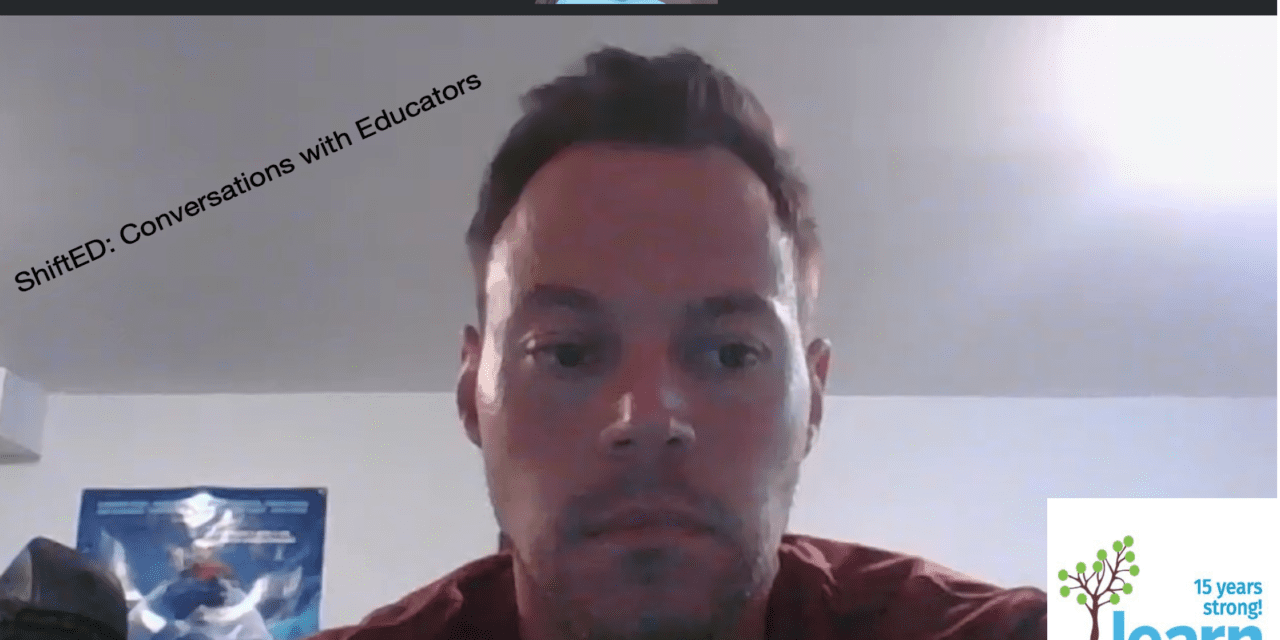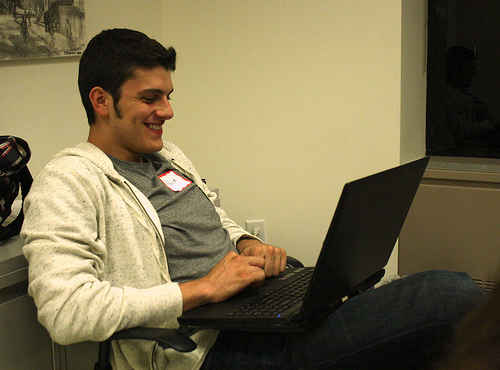LEARN caught up with Jeremy Wouda, ELA teacher at Philemon Wright High School, from Western Quebec School Board (WQSB), who is also an online tutor with LEARN. We talked about how his experiences over the last few months have changed, his strategies to connect with and keep his students engaged online, and what the future might hold for education. Jeremy offers some concrete ways to communicate and track your students using the Instagram app, as well as some simple tips for teaching online. It was a conversation I enjoyed very much, and so will you.
Full Transcript
edited for readability
Chris: [We’re] continuing conversations with educators about their experiences with this transition from face-to-face to a more online. I’m super excited to welcome Jeremy Wouda today from Shawville. He’s part of the Western Quebec School Board (WQSB) and he’s been teaching for about ten years. He’s also been doing some online tutoring for a couple years as well which is particularly interesting for us in these pandemic times. Nice to welcome you Jeremy. How you doing?
Jeremy: I’m doing great. thank you for having me
Chris: Yeah, it’s a pleasure. Jeremy let’s kind of – we’ll rewind a little bit and I just wanted to start talking a little bit about how things were going before March 13th when the pandemic shut everything down. What were you up to in your classes and what were you kind of getting ready for?
Jeremy: Before the world changed, yeah. Actually it was quite interesting because we’re on terms in Quebec so we had the three terms we had just finished up term two. We had our mid-year. We’d counted that as a term two in March. We’re actually sitting on a pretty good bank of information from what our students were able to do. A lot of our students were looking forward to term three because that was the term where they were going to really kick it into high gear and get those passing grades. We had just started our biggest unit of the year. We finally built all those great communities you could trust them to be really engaged as we about to start our Memoir unit. We had just divvied up all of the books which is no small feat when you’re trying to balance who’s reading what and who’s in what group and how are we going to collect information. Then the school shut down. We’re still in the process now trying to get these books back from students. It was quite the kerfuffle when it happened.
Chris: Were you able to –
Jeremy: We were gearing up for a really big project and then boom. Sorry?
Chris: Were you able to do this project online? Was it transferable?
Jeremy: No. So, unfortunately we had to abandon it. What we did was obviously we told the students who had the memoirs, we said, ‘please do feel free to read them.’ I did have a couple of good conversations with some of the students who were reading some of the memoirs. I was able to read most of them beforehand so I was able to talk to them and have mini book clubs with them online. But no we had to abandon the project. It was just too much.
Chris: So many things just kind of ended so abruptly, eh? I think we’re still trying to get our minds around all that as well, eh? All the sporting events were cancelled, the proms, the graduations, the projects, the school trips. It’s been a real shaking of the foundation for education.
Jeremy: Absolutely. A lot of our students are involved in extracurriculars and I think that’s what hit them the hardest. They lost – they were planning this Europe trip through VF tours – that was scrapped. We have this big musical that Philman puts on every year and we just had a brand new drama teacher in and so this was her first big kick at the can. She was super excited, the students were excited. That was scrapped. We have a very good music program. A lot of things you had to radically change in a hurry, right? I think those first two weeks when we were hoping to get back in, it was a weird limbo because we didn’t know what to do. Then, we found out that it was long term. That’s when things started to really change and not all for the worse. Some things actually, there’s a great opportunity this time as well.
Chris: For sure. Talk to me a little bit about those first two weeks. What was your school – what did you do during those first two weeks when the ministry first shut everything down for two weeks? Was there planning that started to happen about: what are we gonna do with the kids when they come back? or, what are we gonna do if the kids just stay home until the end of the year? What were those conversations like that first couple weeks?
Jeremy: Yeah there’s a lot of speculation as I’m sure you can remember because no one really knew what was going to happen. A lot of the conversations surrounding what happens when the students come back; how are we going to do social distancing; are we gonna have smaller groups since we were really focused on face to face and students being present in the school learning. But as it quickly shifted to this new reality where you wouldn’t be having them back in the school then the conversation started moving too: how are we going to stay connected with the students? And at first it wasn’t even academics that we were worried about. We were worried more about the students losing connection with the school. So our first conversations were about, how do we maintain that connection? What apps are we gonna use? How are we gonna be online? How are we gonna be available to them? So that was sort of the first discussions and then content came a lot later because there’s so many mixed messages from the ministry about what was going to happen, what was required. Was the school year over for everyone? Would there be an opportunity for students to do some work? Would teachers be required to take attendance? There was so many questions and I don’t think any of them are actually fully answered yet. So, that was the first two weeks. It was a wild ride. First, just trying to get anyone back in school. Once that was scrapped, how do we say connected? That was kind of the big questions.
Chris: I really like hearing that too because I think it really shows us what students are really motivated for at school. Where their engagement really comes from and it’s these social avenues all the time, right? The plays, the sporting activities, the friends. Could you talk a little bit of that, to the transfer? How do you maintain that sociability, that engagement for kids wanting to come be a part of a social part of school? How do you address that when you get online for the first time?
Jeremy: Yeah, so that was the biggest challenge, to maintain that engagement. Interestingly, some of my students were writing articles and essays at the end, as part of their mark improvement work that they were allowed to do. Every student, the common thread was: ‘I’ve never been a big fan of school and never really thought I liked it but now that I can’t go and see my friends every day and even the teachers and the sort of routine.’ They really missed it. So that’s our big challenge: How do we maintain engagement? So, the way that we did it was, we held weekly meetings through Zoom, through Teams. Some of the teachers use Teams and then I – My big thing was that I used Instagram. That was my big way of connecting with students. I already had a lot of my students follow me on my teacher Instagram account. So I was able to post daily stories, book recommendations. I made some YouTube videos: How to use our online reading app. I really tried to connect with them that way. Then really, our weekly meetings became…Yeah, there was some academics but mostly it was checking in. How are you guys doing? How are you feeling? What are your stress levels like? It really shows you that schooling is so much more than just writing and reading. As an English teacher, it’s really about building those relationships and helping these young people figure out life and that really became clear in this time.
Chris: Absolutely. Very, very interesting observations. I’m seeing that more and more. Often times, I ask teachers: What do you remember about high school and most of the time, the teachers are going to social things. It’s not the content or the formulas or the dates. It’s really about the lifelong friendships, communities that are formed. And then it gets even a little bit trickier once you start to shift online, right?
Jeremy: Yeah, absolutely. So much of your high school experience is the time in between the classes. Whether it’s in the hallways with your friends or even just at those extracurriculars with your teachers, either sporting or dance, or music, or whatever it is. So to try to replace that with an online presence is so hard because you’re removing…Well, you’re not removing the social aspect but it complicates things greatly and it makes it more of a challenge for sure.
Chris: I’m curious about your Instagram. I think that’s such a brilliant idea because kids are using it, right? Kids do Instagram so it’s something that they’re already comfortable with that you’re finding an avenue where you can fit in to this sociability amongst themselves. Can you talk a little bit about that? What was the reaction of the students when they had a place to meet with you on their social media?
Jeremy: So, I’ve experimented with different social media apps. I briefly tried to use Twitter. I had a Mr Houda Facebook page but that was a nightmare. I found Instagram works really well because I was able to create a public space for myself. Create an alternative account so it was not linked to me privately whatsoever which was really nice. I was able to create a theme for the account which in this case was that I do book reviews and I post my books that I read. So I was able to share books that way. But, the real powerful thing for me was the the messaging on it. I’m sure that you know, as all teachers right, we try to email our students and students regard email as this fourth option in terms of communication. So they don’t check their email. But if I needed to contact someone, I could simply look through my follower list, find them, direct message them and just say, ‘Hey! Just checking in. How’s it going? What are you reading?’ or whatever it is that I was talking about and they would reply within minutes. Off within seconds. Obviously their phones are glued to them. So I found that to be a really great way to meet them and among other things, I did all kinds of really cool stuff with Instagram over these COVID weeks, if you will.
Chris: Let’s talk a little bit because there are so many things out there. So many resources, so many online things. We just get links and links and links, eh? What are some of your go-to resources that you have been using quite regularly online? What are some of those resources that you might suggest?
Jeremy: So, I’m a parent too right? I have a kid. My son, he’s in high school, grade seven and he was being overwhelmed with links to different resources and apps. So I really try to keep it simple. The teaching team and I, we created a Google Doc and we almost used it as a website really and linked everything from that doc and created a weekly schedule. But the real thing that I used was through Instagram. I would use daily stories to show the students, this is what I’m expecting you to do today, if you’re interested. Obviously it was all optional. Let’s say one week I was doing short stories, I post a little short Instagram story saying, ‘Hey, here’s the story!’ I put a little excerpt on it, try to tease them into reading it, and say the link’s in my bio. Every day, I just update the link in my bio on Instagram to the PDF version of that story online for them to read. They literally just have to click one button and they could read the story and then obviously we could have a conversation about it. I’d use the poll questions on Instagram to see what people were thinking about the stories I was posting. I think my biggest success was that I did a sitcom week. We talked about the codes and conventions of sitcoms. I did a little bracket challenge and pignoli sitcoms against each other and there’s a lot of a lot of engagement. There was a lot of anger and passion about what should be the best sitcoms. Instagram was huge and Google. I use Google Forms. I’m sure going into the fall, I’ll be using a lot more apps. I’ve used flipgrid before. I’ll probably use that more often. Probably some Voicethreads, things like that to deliver content but I think for this time period, keeping it simple was so important because these kids were being inundated. There’s six, seven teachers for different courses. They were getting all kinds of different stuff so I was trying to keep it really like: ‘Here’s the stuff. It’ll never change. The link will never change. You’ll always find your information here.” That seemed to work pretty well.
Chris: You also tutor online for LEARN as well. So you’re a teacher at a high school but you also do this, I don’t know where you find the time for all this Jeremy, but some tutoring online as well. What are your strategies? What are your go-to – If I’m a new teacher coming online and I’ve never taught online before, what kind of advice or strategies would you share with that educator?
Jeremy: I think the big thing we have to really think about as online teachers, and this is something that I had learned the hard way, was that you’re not gonna get engagement unless you really start seeing the student as a real person. I know that sounds like evident, right? Of course they’re a real person but this whole disconnect between screens, it really creates a barrier. We all know about how people can go onto social media sites and say absolutely horrible things and defend it by saying, ‘oh it’s not real it’s online.’ But that happens as an online teacher-student relationship as well. Some of the big things I suggest is you have to make sure that you have at least your photo for people to see you as a real person so they can put a face to the voice. Try to use video as much as possible when you’re chatting and talking. If you’re teaching a huge class, trying to break out into smaller groups so that you can have one on one face time with these people is important. Then obviously just meeting the students where they’re at. If they’re using Instagram, message them through Instagram. If they would prefer that you only email them, just email them. It’s gonna take some flexibility on your part to try to to constantly search to be in contact with them but to meet them where they’re at because it’s all new and scary for them too.
Chris: Absolutely. I think educators sometimes forget that as well, that the students are transitioning as well. This is is all new to them as well because teaching is not just online. Those are amazing strategies, I love those.
Jeremy: We sometimes think that because the students are young that they’re totally with it and they get technology, they get computers. But a lot of these students have not had any training with computers and technology so it’s brand-new for them and it’s hard for them to do. The more that we can make it a comfortable, real experience, I think the better.
Chris: Jeremy, what’s the flip side of that? Some great strategies that you presented and talked about, what are the greatest challenges of online teaching? If you – I love your answers because they’re very simple and concise and they make a lot of sense. What’s the flip side of that? What do you think the greatest challenges are gonna be for educators if, come September, we have to do online teaching again? What are those challenges that you think?
Jeremy: Number one challenge will be engagement and how do you get the student to be present, to be involved in the learning. Obviously, when you have them in the classroom, you can minimize distractions. You can say, ‘put away your phone, no you can’t talk to that person, no you can’t get up and wander around.’ But when they’re gonna be learning from their homes, we have to create the content and the tools that will be so accessible and so engaging for them, that they’re gonna want to buy in. That’s gonna be the huge challenge. How do we get them to show up and to be present, to want to be there, to want to work. That’s gonna be the big thing. Again, trying to make it as real as possible. As human as possible is the go-to because that’s gonna be our big challenge for sure.
Chris: Yeah absolutely. I like your ideas too that even before we can get into any kind of content, establishing this connection with your students, right? Even when we do, when we’re in class face-to-face, you got to build those relationships with those kids or there they’re gonna be at an arm’s length. Whereas if you build relationships and they trust you and all of that good stuff comes, then they’ll be more willing to deal with the content part. But if you don’t have that and even more so now online, if you don’t have that connection with those kids, it’s gonna be tough.
Jeremy: Absolutely. I mean one of the things I learned through LEARN tutoring, where I’ve never seen these students face-to-face, never met them in real life but I was able to eventually work with a few every week, was if you don’t take the time every session to do a little quick check in. You only have them for 30 minutes when you’re doing LEARN tutoring. You want to get to the work but you just do that quick check-in. Then I always try to gear everything I was working on with them to their interests. So, I had one student who loves snowboarding. Everything we did was about snowboarding. If we’re gonna write, we’re gonna write about it. If we’re gonna read, let’s read about it. Let’s talk about it. It gives them that buy-in that what I’m doing matters and it has value. We do that in the classroom. It’s so easy to do it in a classroom and I think, if you take those same philosophies and move them online, the students will buy in. Because again, like you said earlier, students don’t remember the individual assignments but they do remember teachers – the ones that cared, the ones that built relationships and that should be your goal I think whether you’re online or face-to-face. That’s my goal anyways.
Chris: Amen. I think you’re spot on. I think you’re really spot on and with that and wow! I want to thank you for your words. I think that you’ve said a lot of great things that teachers will like to hear and I think anxiety. Because it is simple, right? It is about relationships and if that’s at the forefront of online learning then I think we can have success and we can have learning take place. But, it’s gonna be a transition getting there for sure.
Jeremy: Absolutely. I’ve had conversations with all kinds of teachers at my school. Some are excited, some are worried. I keep trying to phrase it, I say, ‘you know guys, it’s a great opportunity. Yes it’s going to be tough but we are finally, almost forced, to use the wonderful world of technology. We’ve been dragging our heels on that as a teaching professions. Let’s embrace it. Let’s use this opportunity to really make some cool things happen. So I’m worried absolutely but I’m very excited about September and what this new year is gonna look like.
Chris: For sure, for sure. I like that excitement too because change, you can’t have progress without change, right? I think pushing our system a little bit more towards a progressive learning style is really key and like you said, now it’s ripe for the pickin, right now. If there was ever a time to change, now is the time.
Jeremy: Right, exactly. If you look at you know progress throughout human history, it’s often been when terrible things happen, humanity rises to the challenge and makes great leaps and I think this is a pretty rough time for education. But I think we can rise to the challenge and make some pretty cool moves forward as a teaching profession. There are a lot of challenges for sure but I’m mostly excited about what’s gonna happen in September.
Chris: Awesome. Well Jeremy, I want to thank you again for spending a bit of time with me and having this great conversation. I really appreciate it. I’m glad that that we were able to find the time and I want to wish you a great summer. Hopefully, you’ll have a bit of time to just disconnect and forget about it all for a little bit before August rolls back around and it’s showtime, as we like to say.
Jeremy: I appreciate you having me. I’m doing the online. It’s good. I’m looking forward to the break. I think I’ll be doing some online with summer schools LEARN as well. You can’t take too much time off, that’d be ridiculous.
Chris: Well thanks and all the best to you. I’m sure we will continue this conversation in the new year.
Jeremy: Alright. Awesome thank you so much.





